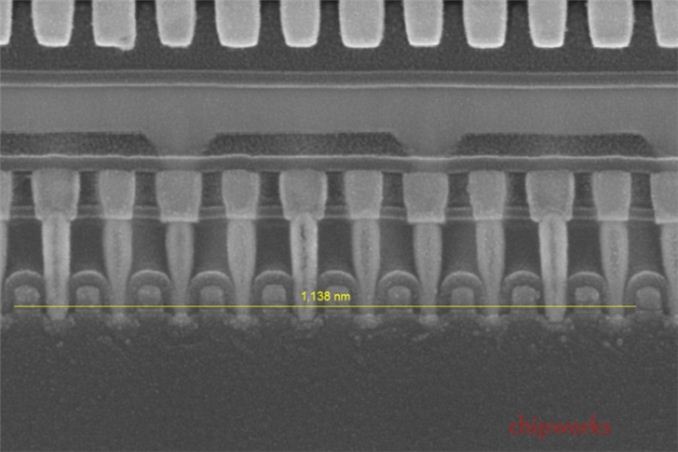Chipworks Confirms Apple's A7 is Built On Samsung's 28nm HK+MG Process
by Anand Lal Shimpi on September 20, 2013 5:09 PM EST- Posted in
- Smartphones
- Apple
- Mobile
- SoCs
- iPhone 5S

Chipworks is in the process of delayering Apple's A7, but they just confirmed what we mentioned in our iPhone 5s review: Apple's A7 is built at Samsung using their 28nm HK+MG process, the same used for the Exynos 5410/5420. The confirmation comes by looking at contacted gate pitch, which is similar to that of other devices using Samsung's 28nm HK+MG process (and smaller than the previous generation 32nm A6). I'm sure we'll get more details once Chipworks goes further.
Apple has been running test silicon at TSMC for a while now, and will likely shift the production of some silicon there in the not too distant future. I'm not expecting a clean switch from Samsung to TSMC, but rather a hybrid solution where Apple produces some silicon at TSMC and some at Samsung. We may even see it split across SoC lines rather than a mix for one SoC.
Rumors of an Intel foundry deal cropped up again recently, but it's far too early for something like that. Not to mention that the deal that was being worked on wasn't for 22nm.










24 Comments
View All Comments
Hyperlite - Friday, September 20, 2013 - link
I know it's pretty standard practice in the industry, but i still find it infinitely ironic.ArthurG - Friday, September 20, 2013 - link
Apple has no factory, what you think they can do ? They rely on others for all their hardware so they just try to find the best deal in everything...Kevin G - Friday, September 20, 2013 - link
The Intel foundry deal rumor has cropped up again?I get it why the manufacturing side of Intel would want this but the x86 of the company has to be irate about the idea of supporting a direct competitor. Remember, Intel is keen to push x86 into smart phone via Atom and manufacturing chips for a smart phone competitor doesn't bode well for Intel's image. Not to say that Intel couldn't be successful in both selling x86 silicon in mobile devices while simultaneously fabing chips for Apple's iPhone, it doesn't make for good marketing when you're trying to really break into a market.
Bob Todd - Friday, September 20, 2013 - link
True, but fabs are expensive assets. I remember reading something earlier this year speculating that their fabs were running around 60% utilization. Their process advantage is still large, and I imagine Apple could do some pretty impressive stuff at 14nm/7nm. There's obviously a ton of variables to think through like a possibly uncomfortably small margin for Intel. However I'm sure the chance to have a crack at those nodes well before their competitors is at least intriguing to Apple and others.ltcommanderdata - Friday, September 20, 2013 - link
If Intel has unlikely to get an x86 chip onto an iOS device in the near or even medium term, which seems pretty certain now that Apple is investing for the future in 64-bit ARM, and iOS devices still represent significant volumes even if it is behind Android, then Apple really isn't a direct competitor to Intel chips. It's not like Apple not using Intel chips in their iOS devices is going to drive a lot of customers away from iOS. iOS devices will continue to sell and sell well regardless of whether Intel x86 chips are in there or not. Fabricating Apple's chips would be an additive business for Intel rather than leaving a segment of the market untouched.Kevin G - Saturday, September 21, 2013 - link
There is of course the threat that Apple could migrate the Mac line to ARM in the future. Apple did state that the A7 was 'desktop' class which I see as indicative of where the Mac platform is going to go in the long term.MartinT - Friday, September 20, 2013 - link
Well, there is the old adage about Intel being primarily a process development and production company that just happens to also keep a design house around, mostly to generate the revenue that fuels development of the next node.Manufacturing is certainly the one part of the chain Intel is most dominant at, and has been for many a year.
Once they ran out of in-house transistors to print on their shiny wafers, you saw them restarting their foundry business, and unless x86 suddenly replaces ARM in the mobile space, you'll only see this continue. Those FABs have to be fed.
errorr - Friday, September 20, 2013 - link
Why couldn't intel offer up an n-1 fab strategy. Their process advantage is heads and shoulders beyond even TSMC let alone everyone else. We see TSMC start bulk 20nm in Feb. Assuming low yields early on and intel having 14nm up an running aroind the same time why couldn't we see intel offer to do volume 22nm finfet for the right customer?Most of the so called excess capacity that intel has is figuring out how long they can continue to monetize the older nodes.
beginner99 - Sunday, September 22, 2013 - link
Yeah i wonder about this too. n-1 would make so much sense because almost everything is now integrated and hence chipsets are also on the same node. So factories get unused much faster. One can dream about NV/AMD GPUs made by intel 22/14 nm. :Dmichael2k - Sunday, September 22, 2013 - link
You are confused. They will be ramping up their high power 14nm process in Feb, their low powered process won't be up for another 12 months at least. If they were to go N-1 then they would be offering 22nm this time next year, at the same time TSMC will be running their 20nm process.